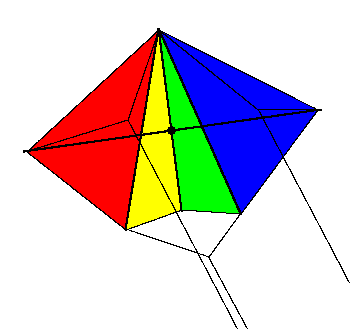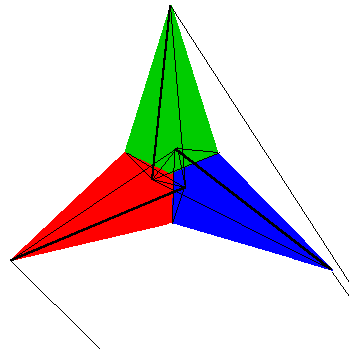 -
Continue the
-
Continue the

In a triple line kite, the third line allows the angle of attack to be adjusted, so the forward speed can be controlled without walking forwards or backwards to control the joint tension of the lines. Consequently, such a kite can be made to go backwards apart from simply by stalling it.
It would be possible to control a triple line kite with your two hands and the third line attached to your belt, but in practice, a triangular or Y-shaped handle is used, allowing it to be controlled with one hand.
Triple line kites are not common and have never really caught on. Nevertheless, there are several that have been discussed on the Internet, and if you want something different, they may well be worth exploring.
 The Joystick Kite, by Eola Gayla of Spain looks rather like a relatively
low aspect ratio delta, though technically, it should probably be
classed as a barn-door
with an extra longeron. From what I hear, it's fun to fly, but the
dual-line flier I got the report from said he had to keep his left hand
in his pocket to counteract his 2-line instincts. Another flyer
described it to me as purely a fun kite, opening up a whole new aspect
of flying if only for the novelty of only having one hand full. He
described it as reasonably precise but needing a fairly stiff breeze, easy
for a quad line flyer, probably giving you more control over
forward/backward speed than a quad.
The Joystick Kite, by Eola Gayla of Spain looks rather like a relatively
low aspect ratio delta, though technically, it should probably be
classed as a barn-door
with an extra longeron. From what I hear, it's fun to fly, but the
dual-line flier I got the report from said he had to keep his left hand
in his pocket to counteract his 2-line instincts. Another flyer
described it to me as purely a fun kite, opening up a whole new aspect
of flying if only for the novelty of only having one hand full. He
described it as reasonably precise but needing a fairly stiff breeze, easy
for a quad line flyer, probably giving you more control over
forward/backward speed than a quad.
From the sketch, you can see that it has a single cross spar and 3 other spars meeting at the nose. The middle one is held above the plane of the two side panels by a stand-off, seen end-on in the sketch as a blob in the centre. A plastic "joystick" handle with three legs is provided. Here is a picture, which gives some idea of the kite.
 The Synergy 333 and its little brother the Minergy 333, from Guildworks,
is a much more original design, being a 3-point star. To say that it
would fit inside a 46 inch circle gives little idea of just how small it
seems when you handle it, and the Minergy is only a third of the size,
fitting inside a 14 inch circle!
The forward direction is directly away from any one of the points, not
in the direction of a point as one might imagine.
The Synergy 333 and its little brother the Minergy 333, from Guildworks,
is a much more original design, being a 3-point star. To say that it
would fit inside a 46 inch circle gives little idea of just how small it
seems when you handle it, and the Minergy is only a third of the size,
fitting inside a 14 inch circle!
The forward direction is directly away from any one of the points, not
in the direction of a point as one might imagine.
The maufacturer's website gives a good idea of it, and here is a picture of one in flight showing the handle (from Jan Gilhooley's excellent website).
The sail is held taught by 3 carbon spars and a complicated arrangement of 15 lines; from careful study of the sketch you will see that from the free end of each spar, two lines go to the mid points of the adjacent sides, two more to the free ends of one of the other two spars, and one to the next wingtip. This holds the free ends of the spars a few inches off the sail, the edges of which curl towards the spars.
The framework can be fitted to either the front or the back; on the front it's easier to fly, but when fitted to the back it's faster and flies in less wind.
The three flying lines are attached to the three points. The handle is a similar arrangement of three spars strung together; it can be tipped in any direction to control the direction of motion, but for fine speed control you can simply flex the lower spar with the fingers.
Whilst it seems to be a lot of fun to fly, it's vital to keep track of which point is the top. For this reason, if you're thinking of getting one, get one with different coloured points, unless you want a real challenge! It can move in any direction and can even be made to spin, though once it starts spinning there seems to be no easy way to stop it. Judging by reports, you would enjoy this kite if you have the patience and tenacity to master it - the basic technique can be learned in a single session but it takes longer to become proficient. It needs a reasonable wind to fly. The Minergy 333 behaves almost more like a string puppet than a kite and, weighing only 14 grams, can be flown indoors on its diminutive 3-foot lines.
There is also a heart-shaped kite made by Dan Kloss of Tennessee, but I don't have any info on it.
Alternatively, if you want to experiment, a good place to start would be to take a standard diamond stunter and attach three lines to it, one to each side of the cross-spar and the third to the bridle point towards the bottom of the spine. Have fun!
 -
Continue the
-
Continue the







